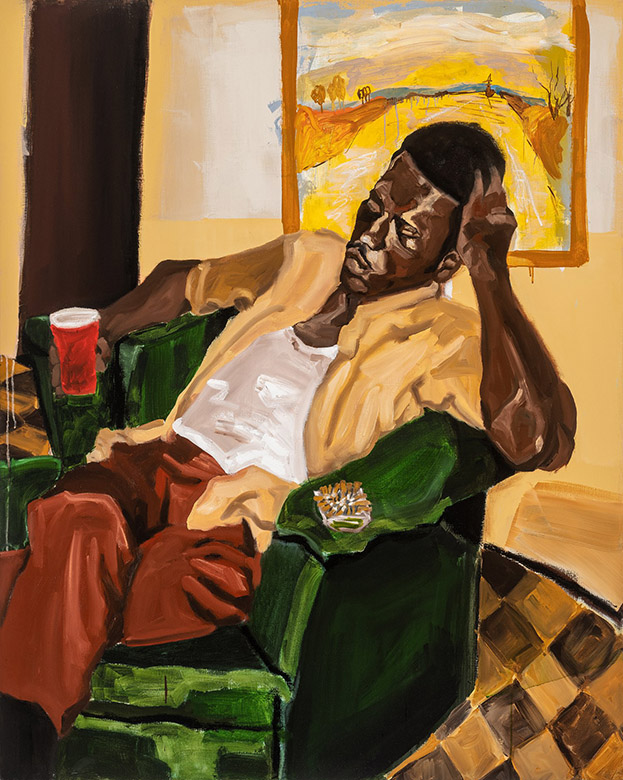
Walters Art Museum feature more Black artworks; (c) Soul Of America
Baltimore’s Woke Museums
In my youth as a Baltimore school boy, there were no inclusive and “woke” museums. I remember visits to the Baltimore Museum of Art, Walters Art Gallery, and Maryland History Museum. Teachers emphasized the importance of Greek and Roman sculptures and history and the importance of Maryland to America’s democratic structure of government. Many times they gloated over master artists from 15th to 20th century Europe and Marylanders who signed the U.S. Declaration of Independence. Though important to recognize, they were not inspiring for me. Hard as I looked, I could not find artists that looked like my family and friends in Baltimore, Washington, Pittsburgh, or New York City. There was nothing in their life experience or perspective that I could connect with. I’m happy to report that Baltimore’s Inclusive Museums take things to another level today.
When I visited as a youngster, there were no museums featuring old-school black entertainers like Billie Holiday, Duke Ellington, Ethel Waters, Count Basie, Cab Calloway, and the Nicholas Brothers. Nor could you find exhibits about Michael Jackson, Prince, Earth, Wind & Fire, Kool & The Gang, and more. Seeing visual artwork by Romare Bearden or Allison Saar was out of the question.
In summer 2021 I shared the results of visits to Reginald Lewis Maryland Museum of African American History & Culture, Baltimore Museum of Art, American Visionary Art Museum, Frederick Douglass-Isaac Myers Museum, and B&O Railroad Museum. Other museums were still closed due to the pandemic or I didn’t have time to visit. In 2022, more museums are open, so I’m updating insights about Walters Art Museum, Maryland Center for History & Culture, Great Blacks in Wax Museum, Baltimore Museum of Industry, and Benjamin Banneker Museum.
Maryland Center for History and Culture (MCHC) was formerly called the Maryland Historical Society Museum. Today, the MCHC has an exciting new long-term exhibition called “Passion and Purpose: Voices of Maryland’s Civil Rights Activists.” Using artwork and historic artifacts, the exhibit takes an unflinching look at Maryland’s role in America’s Civil Rights Movement and the obstacles encountered. It does not “fake the funk” by suggesting that we have overcome. Instead, it insightfully summarizes the bumpy road towards progress. The museum also underscores how early Baltimore became one of the nation’s economic powerhouses before and after slavery.
You can never go wrong including the National Great Blacks In Wax Museum on your itinerary. Their wax figures don’t each have a $250,000 budget for the fine finish of Madame Tussaud Wax Museum figures. But unlike Madame Tussaud’s, every visit here touches something in your soul. There is loving craftsmanship and historical context in each figure that is felt more than seen. It’s like connecting with the elders who made President Obama, Vice President Harris, other black politicians, scientists, educators, attorneys, doctors, and engineers possible today. If you haven’t visited this museum, then you haven’t visited the best of Black Baltimore.
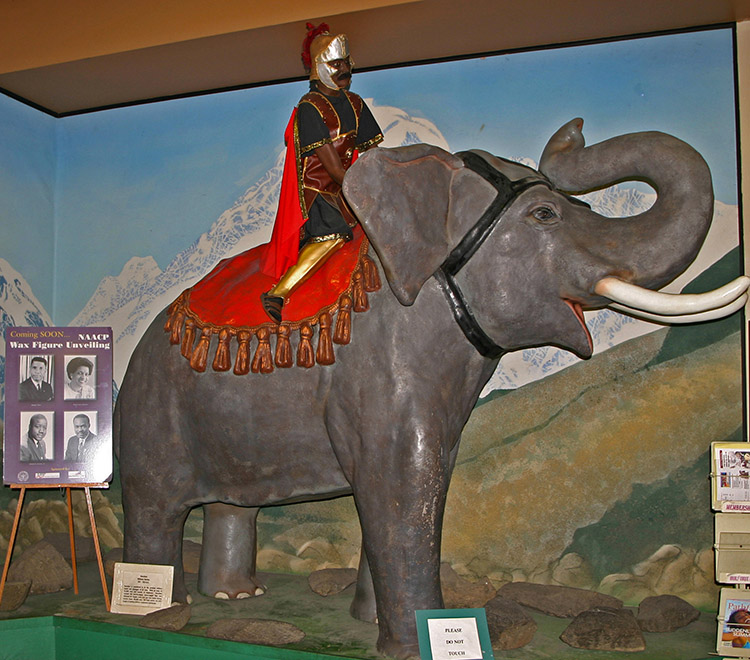
Hannibal exhibit at Great Blacks in Wax Museum; (c) Soul Of America
Walters Art Museum, Peabody Institute of Music, and the nation’s first Washington Monument co-anchor Mount Vernon Arts District. The area teeming with parks, shops, small cafes, and coffeehouses that rime you to enjoy great art. Old money has funded the Walters Art Museum since 1934 and it shows with magnanimous European art galleries. Within its hallowed halls, I’m always drawn to the Egyptian Gallery which has artifacts from arguably, the world’s first great civilization. One can only marvel at their craftwork from a civilization dating back to 3150 BC.
I always struggle with my interpretation of the Benjamin Banneker Historical Park & Museum. It never answers key questions like his troubled relationship with the equally brilliant, but morally hypocritical Thomas Jefferson. It never explains why Banneker did not marry. It never explains what happened to Banneker’s sisters and why their descendants lost of his 142-acre estate after Banneker died in 1806. Considering development around the area, his descendants should have been prominent real estate developers in Maryland. Perhaps a historian will be funded to get at the root of those and more questions to make this a next-level historic museum. For now, it’s a place to bring young black scholars for a small measure of inspiration.
The enigmatic Museum of Industry in South Baltimore is a good family destination too. It highlights much of what made Baltimore a Manufacturing and Shipping powerhouse in the 19th and 20th centuries. I’d like to see more mention, however, of Black workers who were locked out of industrial trade unions and how Isaac Myers shipbuilding & repair company was sabotaged by jealous white companies. I mention those points without malice towards today’s white generation, but it helps explain why Baltimore’s black community failed to employ tens of thousands more people, let them earn higher pay, and build a strong bank. It also helps all people understand why Maryland and America in general, need to repair that damage.
As you see below, there is so much more in the only city with 5 major black museums and more inclusive general museums.
Maryland Center for History & Culture
DESCRIPTION: Founded in 1844 by the Maryland Historical Society, its first building was completed in 1847 near the Washington Monument. The museum features more than 1,000 objects on display in 15 permanent and rotating exhibition galleries. Its library houses 7 million books, documents, manuscripts, and photographs available for research and scholarship. The 3-building complex includes the renovated Art Deco Greyhound Bus Garage as a gallery. It contains a mural exhibition of the Royal Theater, Pennsylvania Avenue, and the former Afro-American Newspaper headquarters on Eutaw Street. The venue contains nine portraits by Joshua Johnson, the first professional African American artist in the United States. You can also find a fashion archive of 12,000 garments and accessories spanning four centuries; the world’s largest collection of Baltimore Album quilts and Native American archaeological artifacts dating to 5,000 BC round out the permanent collection. Most recently the MCHC features Visions of Night: Baltimore Norturnes exhibition and Passion and Purpose: Voices of Maryland’s Civil Rights Activists exhibition.
ADMISSION: $9 Adults, $7 Seniors, Free for age 18 and under, and Students with ID
DAYS & HOURS: Wed-Sat 10a-5p, Sunday Noon-5p; Library closed on Sunday
ADDRESS: 610 Park Avenue, Baltimore, MD MAP
PARKING: Parking onsite or surrounding streets
RAPID TRANSIT: Centre Street Light Rail Station
PHONE: 410-685-3750
WEBSITE: https://www.mdhistory.org
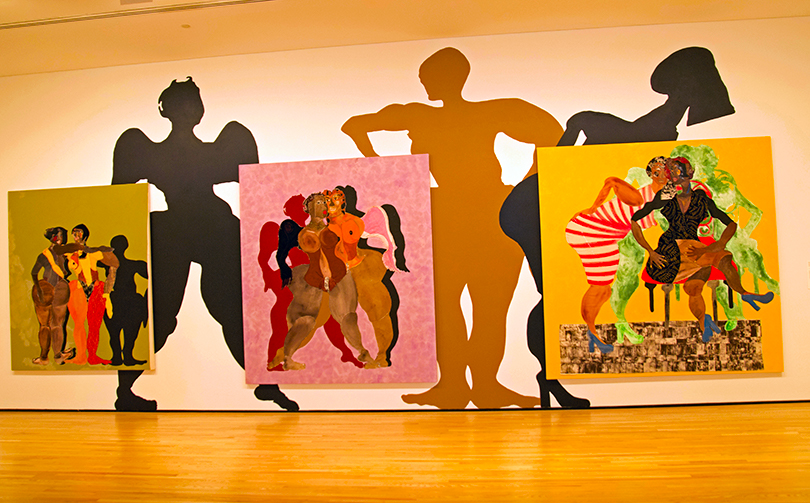
By My Self by Tschabala Self at Baltimore Museum of Art ; (c) Soul Of America
Baltimore Museum of Art
DESCRIPTION: Maryland’s largest art museum showcases a dazzling collection of ancient mosaics, European masters classics, contemporary art, and sculpture gardens adjacent to the Johns Hopkins University campus. The main building was designed in the 1920s by renowned architect John Russell Pope and an impressive wing for contemporary art was added in 1994. It’s home to an impressive collection of artwork by Matisse, Picasso, Monet, Cezanne, Gauguin, and Van Gogh. Along with its extensive collection of 18th and 19th-century American art, the museum has 16 galleries filled with one of the country’s best collections of 20th-century Post-Impressionistic pieces and a permanent exhibit of African art. The museum has made dramatic progress in showcasing artworks and themes important to the black community, including Black Lives Matter. It is wheelchair accessible and features an eclectic gift shop and scenic restaurant. We heartily recommend it.
ADMISSION: Free
DAYS & HOURS: Wed-Fri 11a-5p; Sat-Sun 11a-6p
ADDRESS: Art Museum Drive at North Charles Street and 31st Street, Baltimore, MD MAP
PARKING: Johns Hopkins University South Parking Garage
RAPID TRANSIT: none
PHONE: 410-396-7100
WEBSITE: https://artbma.org
National Great Blacks In Wax Museum
DESCRIPTION: Top-Tier Historical Wax Museum; Founded in 1983 and expanded in 1987 in an unused fire station, Victorian Mansion, and two former apartment dwellings to provide 30,000 square feet of space, it is the most remarkable museum of its genre. This museum contains over 100 wax figures and historic scenes, a full model slave ship exhibit telling the 400-year history of the Trans-Atlantic Slave Trade, and a room highlighting the contributions of outstanding Marylanders to African American history. The gift shop and mini-auditorium for lectures, films, and presentations round out the venue. All the lifelike displays are enhanced with special lighting, and effects with particular attention to the accuracy of skin color. Each display is presented chronologically from ancient Africa, the Middle Passage on a slave ship, slave revolts, the Antebellum and Postbellum periods, Reconstruction Era, Harlem Renaissance, and the Civil Rights Movement to the present. Among the historic wax figures is The Queen of Sheba, Hannibal, George Washington Carver, Booker T. Washington, Colin Powell, Paul Robeson, Rosa Parks, Mary McCloud Bethune, Matthew Henson, Billie Holiday, Earl Graves, Howard Rollins, and President Barack Obama. They have acquired the entire block for future expansion and parking.
ADMISSION: Modest fee
DAYS & HOURS: Tue-Sat 9a-6p
ADDRESS: 1601-03 East North Avenue, Baltimore, MD
PARKING: street only
PHONE: 410-563-3404
WEBSITE: http://greatblacksinwax.org
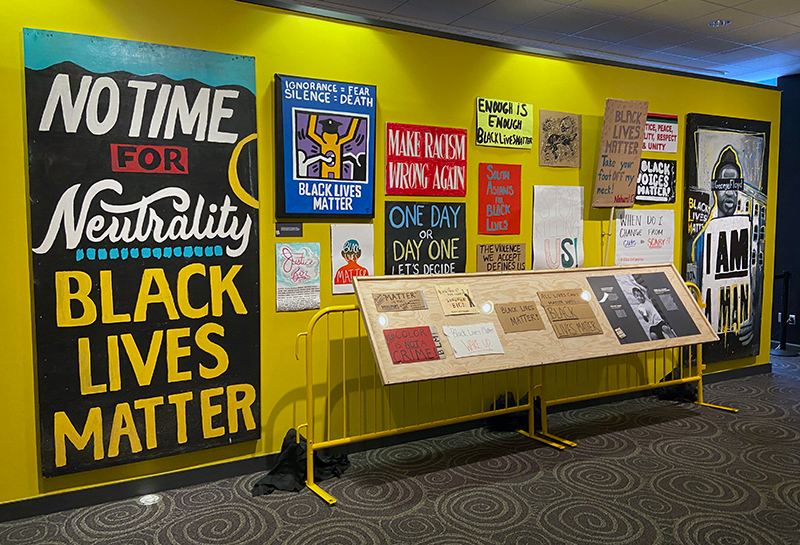
Black Lives Matter exhibit at Reginald Lewis Museum; (c) Soul Of America
Reginald Lewis Maryland Museum of African American History & Culture
DESCRIPTION: A Top-Tier Museum and Cultural Center; In 2005, this compelling black culture museum opened to great acclaim for its stylish architecture and close proximity to Baltimore Inner Harbor. It is made possible by the generous philanthropy of his widow Loida Lewis. Reginald Lewis (1942-1993), a Baltimore native, was the first African-American to build a billion-dollar company. The award-winning architectural team of Frelon Group/RTKL joint-ventured to create a building that evokes a complex range of emotions at every angle, day or night. As a Smithsonian Institution Affiliate, museum exhibitions give a high-quality presentation of Maryland’s African-American heritage of perseverance and triumph. Three galleries trace the African American communities in Maryland: Labor and the Black Experience Black Art and Intellect. Traveling exhibitions are often hosted for 3 to 5 months. The Black Lives Matter exhibit was particularly moving. This multi-level museum has space to host special events and includes an attractive Museum Café. The well-stocked Museum Store almost dares your conscience to leave without a purchase. There are many great gifts, only limited by your imagination. If your itinerary includes the Baltimore Inner Harbor, this is a must-visit.
ADMISSION: modest fee
DAYS & HOURS: Mon-Sat 8:30a-5p
ADDRESS: 830 East Pratt Street, Baltimore, MD
PARKING: garage nearby
RAPID TRANSIT: Metro Shot Tower-Market Place Station
PHONE: 443-263-1800
WEBSITE: https://www.lewismuseum.org
Walters Art Museum
DESCRIPTION: Acclaimed as one of America’s greatest art museums with a collection spanning 55 centuries, 30,000 objects are housed in three wings. It presents art from pre-dynastic Egypt to Greek sculpture to Roman sarcophagi to Old European Master paintings and now 20th-century Europe, Art Deco jewelry, and 19th-century masterpieces. The renovation & expansion dramatically presents many more objects. An extensive gift shop and café are on the premises of this treasure in the Mount Vernon Arts District.
ADMISSION: Free; but fee-based guided group tours are available
DAYS & HOURS: Wed-Sun 10a—5p
ADDRESS: 600 North Charles Street, Baltimore, MD MAP
PARKING: Cathedral and Centre Streets
RAPID TRANSIT: Centre Street Light Rail Station
PHONE: 410-547-9000
WEBSITE: https://thewalters.org
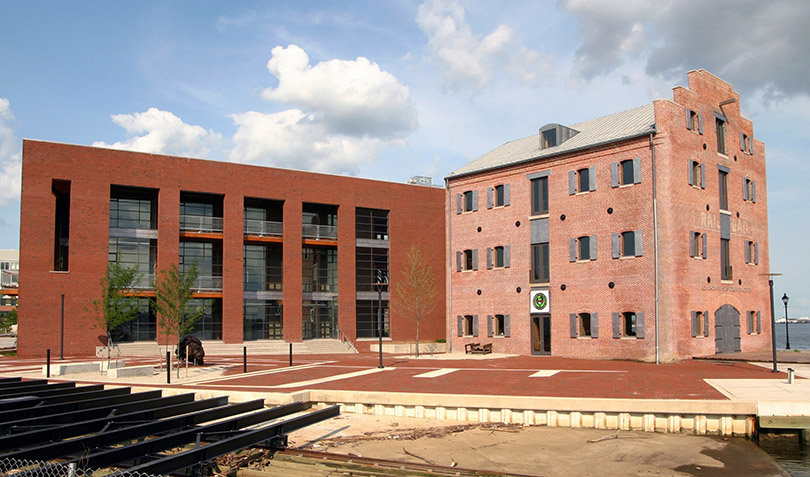
Frederick Douglass-Isaac Myers Maritime Park; (c) Soul Of America
Frederick Douglass-Isaac Myers Maritime Museum
DESCRIPTION: Medium-tier history museum that includes a maritime park. Founded in 2006 and situated in a prime spot connecting the Inner Harbor East to Fells Point, this 5,000-square foot black heritage site, museum, and maritime park merge a modern structure of gallery space with the historic Sugar House. The complex is divided into permanent and temporary galleries and interactive learning centers. The Sugar House building was once owned by Isaac Myers, a free African-American who became a founder of the Chesapeake Marine Railway and Dry Dock Company. As CEO, he employed Frederick Douglass and helmed the largest black-owned business in the 1800s. A section of the museum is devoted to the saga of Frederick Douglass’ life in Baltimore as an enslaved child and young man working on the Eastern shore of Maryland and on the docks of Baltimore. Unfortunately, the white establishment at that time was jealous of the company’s success. So they twisted laws to separate Isaac Myers and his co-owners from the property. But as Dr. Martin Luther King once said, “Truth crushed to earth shall rise again.” Within the historic Sugar House, the oldest standing industrial building on the Inner Harbor lies the Alex Brown Maritime Education Center. A unique feature of the museum is its education programs teach ship building and repair skills to at-risk youths. Docent-led tours are included in the admission. High recommended!
ADMISSION: $15 and less
DAYS & HOURS: Tue-Sun 10a-5p
ADDRESS: 1417 Thames Street, Baltimore, MD
PARKING: Paid parking on Caroline Street in the PMI garage
PHONE: 410-685-0295
WEBSITE: http://www.douglassmyers.org
American Visionary Art Museum
DESCRIPTION: A hard-to-describe, critically acclaimed architectural jewel housed in a 35,000-square-foot main building that was formerly a paint factory; the museum contains six galleries filled with cutting-edge art presented in novel ways. The adjoining barn, formerly a whiskey warehouse with 45-foot ceilings, makes for light spirits as you wander among its ample sculptural exhibits, which include We Are Not Alone: Angels and Other Aliens. It is best experienced, rather than categorized.
ADMISSION: Adults $11, Students $7
DAYS & HOURS: Tue-Sun 10a-6p
ADDRESS: 800 Key Highway, Baltimore, MD MAP
PARKING: on Covington Street and Key Highway
RAPID TRANSIT: bus
PHONE: 410-244-1900
WEBSITE: http://www.avam.org
Carl Murphy Fine Arts Center
DESCRIPTION: Medium-tier museum and performing arts center. MFAC opened in December 2001 with a rousing performance by world-renown operatic vocalist Jessye Norman.
ADMISSION: small fee
DAYS & HOURS: Tue-Fri 10a-4p, Sat 11a-4p, Sun 12a-4p
ADDRESS: 1700 East Cold Spring Lane, Baltimore, MD
PARKING: parking lot and garage on-premises
RAPID TRANSIT: none
PHONE: 443-885-4440
WEBSITE: https://www.morgan.edu/mfac
Star Spangled Banner Flag House
DESCRIPTION: Glimpse the small rooms of home life in the early 19th century at this museum dedicated to the story of Mary Young Pickersgill. See who made the 30×42 foot Star-Spangled Banner that flew over Fort McHenry during the War of 1812 and inspired Francis Scott Key to write the poem that became America’s National Anthem. Be surprised at how small the rooms are and people must have been. Her original flag now hangs at the Smithsonian Institution in DC, a replica is displayed in the garden. Located behind the Reginald Lewis Museum, this museum was founded in 1927.
ADMISSION: small fee
DAYS & HOURS: Tue-Sat 10a-4p, last tour begins 3:15p
ADDRESS: 844 East Pratt Street, Baltimore, MD MAP
PARKING: Central Parking Harbor Park
RAPID TRANSIT: Shot Tower-Market Place Metro Station
PHONE: 410-837-1793
WEBSITE: http://www.flaghouse.org
Benjamin Banneker Museum & Historical Park
DESCRIPTION: Honors the legacy of a Free African American Intellectual who lived during the 1700s. Located on 142 acres in the Patapsco River Valley near Catonsville, the Park & Museum offers public and private programs focused on Banneker’s life, his work to finish the landscape design of Washington DC, and his relationship to the land he inhabited. The verdant grounds with picnic tables are a great place to schedule a family reunion. Make your reservation.
ADMISSION: Small fee
DAYS & HOURS: Tue-Sat 10a-4p
ADDRESS: 300 Oella Avenue at Old Frederick Road, Oella, MD
PARKING: on-premises
PHONE: 410-887-1081
WEBSITE: https://friendsofbenjaminbanneker.com
